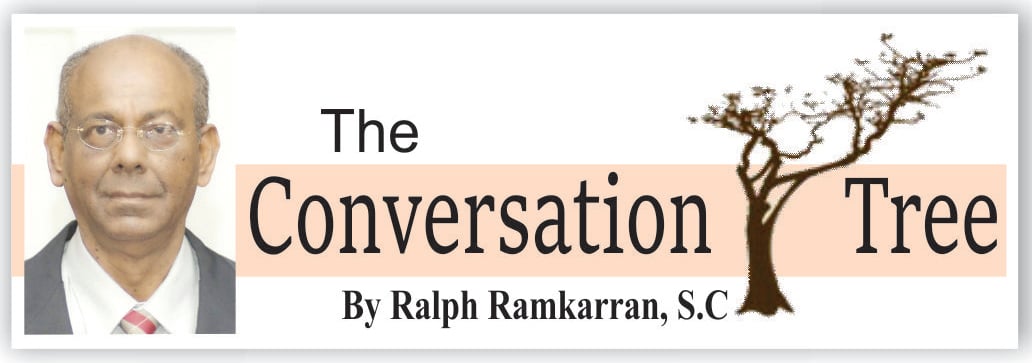 Marxism has been in the news recently with our governing political party, the PPP, finally removing it from its constitution on the ground that it’s an ‘ism,’ a relic of the past. There are good reasons, other than immediate political gain or convenience, for removing Marxism-Leninism from the PPP’s constitution which I have advocated in these columns in the past. In any event, the PPP, seeking to preserve the baby while throwing out the bathwater, declared full-throated adherence to the working class and its interests, did not succeed in exorcising Marxism from its constitution.
Marxism has been in the news recently with our governing political party, the PPP, finally removing it from its constitution on the ground that it’s an ‘ism,’ a relic of the past. There are good reasons, other than immediate political gain or convenience, for removing Marxism-Leninism from the PPP’s constitution which I have advocated in these columns in the past. In any event, the PPP, seeking to preserve the baby while throwing out the bathwater, declared full-throated adherence to the working class and its interests, did not succeed in exorcising Marxism from its constitution.
It was Marx who identified the working class as a distinct group with a specific role separate and apart from other classes and required an independent political entity to represent its interests. Political parties and trade unions purporting to represent “workers” interests have proliferated as a result, some drifting into social democracy. Professor Eric Hobsbawm, a leading authority on European history, has suggested that this was Marx’s most important legacy. The PPP, therefore, as a “working class party,” unwittingly identifies itself in a fundamental sense as an heir of the Communist Manifesto, even as it seeks to extricate itself from his embrace.
Marxism’s continuing relevance was demonstrated as late as 2008. Economists had long predicted that the boom-and-bust cycle of capitalism that Marx had analysed, had ended. Capitalism was supposed to have overcome one of its most devastating, periodic, afflictions. Ben Bernanke, the US Federal Reserve Chair in 2008 and an expert in the US Great Depression, believed along with many others, that the fluctuations in the business cycle in developed countries was at an end because of more flexible policy measures resulting from greater central bank independence. When the economic crisis hit the developed world in 2008 and the “boom” that prevailed hitherto degenerated into a “bust”, economists scrambled to find answers, including dusting off the discarded texts of Karl Marx. A brief resurgence of interest in Marx followed until it was theorized that “financialization” was the culprit that caused the crisis. Well, the developments of capitalism which provide the background for “financialization,” and “financialization” itself, were explained by Lenin in “Imperialism, the Last Stage of Capitalism.” If Marxism-Leninism is a relic of the past, its ghosts haunt us to this day.
Marx and Marxism were products of the Enlightenment and opened up new and innovative ways to understand the world. Marx was part of a European movement that embraced philosophy, sociology, political economy and other disciplines in the search for answers to the burning questions of the day, including how to end autocratic rule in Europe. It was expected that the removal of that “relic” of feudalism, autocracy, would open the way for the unhindered development of capitalism which, though seen as a revolutionary development at the time, was not without critics because of its economic and political excesses. The Soviet Revolution of 1917 upended the idea of Marxism by bypassing capitalism, argued for by Lenin in his “April Theses.” State planning, party rule and Stalinism followed. Marxism took the hit but its main idea – the existence of the working class and its relevance – survived.
The idea that the working class is exploited by having to sell its labour power in a system of unequal relations, led to the notion of its liberation. This notion of liberation spread to other areas of exploitation which led to poverty and injustice. The end of colonialism, the continuing fight against oppression and injustice, are the positive influences that emerged out of the recognition of an exploited class. Less directly, these advances have inspired struggles against war, racism, poverty, for national liberation, gender discrimination and for women’s rights and against climate change. Dien Bien Phu, inspired by nationalism and socialism, is being celebrated this month.
Not all of Marxism has survived, such as “the dictatorship of the proletariat.” Others were modified, which is not unusual. Just as there are many versions of the same religious, philosophical or scientific phenomena, different versions of Marxism had emerged, all claiming legitimacy. There was “pure” or Soviet Marxism-Leninism, Maoism, Euro Socialism, Titoism, African Socialism, the Juche Idea, socialism with Chinese characteristics and others. While the influence of Marxism has dimmed and these ideas are less important, the struggle against exploitative ideologies, such as neo-liberalism, proceeds apace.
The idea of a ”national democratic state,” embracing political and ideological plurality – a post-Gorbachev modification – has been retained in the PPP constitution. It was designed by Marxists as the intermediate stage after the capture of influence by progressive or revolutionary forces in a country where the “working class” and productive forces are not developed, and imperialist interference was a major hazard. The “national democratic state” was designed to maximize the unity of all progressive forces by including non-working-class forces and recognizing ideological plurality. It was expected to be an historical process of indeterminate length and the route through which a “revolutionary democratic state” would emerge, leading eventually to a “socialist” state. Retaining a “national democratic state” and “democratic centralism,” but expunging “Marxism-Leninism” from the PPP’s constitution, are odd ways of re-orienting the PPP’s constitution to the dominance of the prevailing ideological, economic and international realities, where the PPP already resides.
(This column is reproduced with
permission from Ralph Ramkarran’s blog, www.conversationstree.gy)









